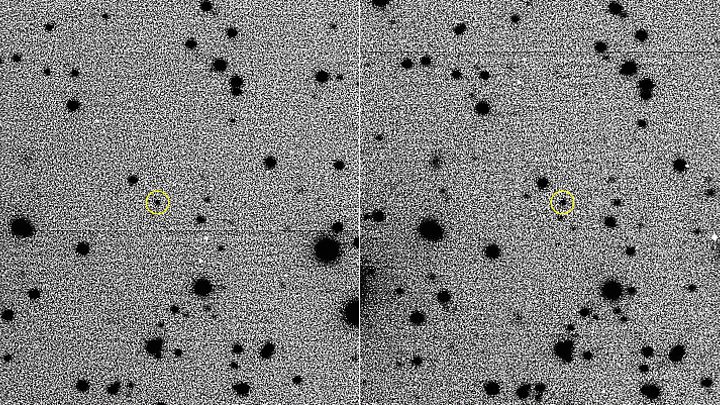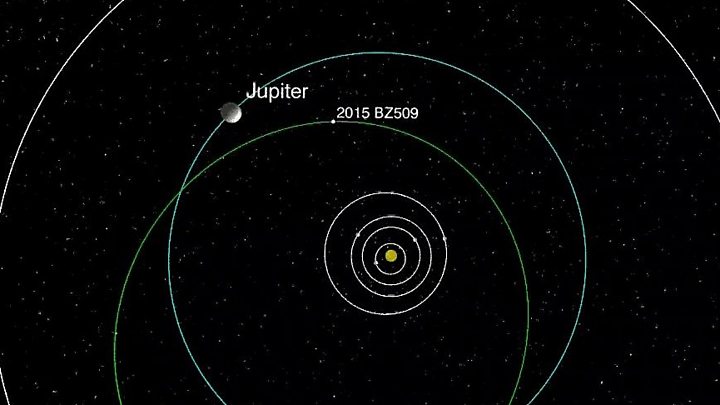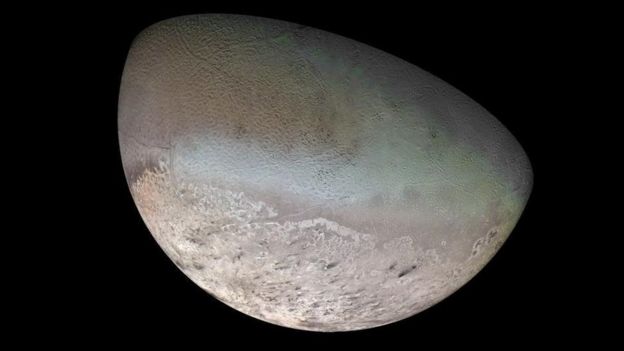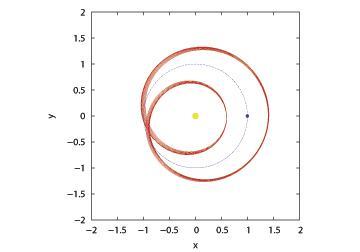21.05.2018
Einwanderer aus der Unendlichkeit

Eine NASA-Illustration zeigt die "Trojan asteroids", die auf der Umlaufbahn des Jupiters in derselben Richtung kreisen: Der Asteroid 2015 BZ509 kreist entgegen der üblichen Flugrichtung. (Quelle: NASA/JPL-Caltech/dpa)
-
Dieser kleine Planet ist anders. Er umkreist unsere Sonne als eine Art Geisterfahrer. Und kommt von einem anderen Stern. Astronomen haben eine einmalige Entdeckung gemacht.
Astronomen haben erstmals einen dauerhaft in unser Sonnensystem eingewanderten Asteroiden identifiziert. Der Brocken mit der Katalognummer 2015 BZ509, der aus einem anderen Sonnensystem stammt, ist eine Art kosmischer Geisterfahrer. Er bewegt sich ungefähr auf der Umlaufbahn des Riesenplaneten Jupiter um unsere Sonne, kreist aber in entgegengesetzter Richtung zu fast allen anderen Himmelsobjekten unseres Systems.
Fathi Namouni vom Observatorium der Cote d'Azur in Frankreich und Helena Morais von der Staatlichen Universität São Paulo in Brasilien stellen ihre Analysen im britischen Fachblatt "Monthy Notices of the Royal Astronomical Society: Letters" vor.
Ein anderer Besucher verschwand wieder aus unserem Sonnensystem
Im vergangenen Jahr hatten Astronomen den Besucher Oumuamua aus einem fernen Sonnensystem beim Durchflug beobachtet. Der Asteroid war nach seiner Stippvisite wieder in die Unendlichkeit entschwunden. 2015 BZ509 ist dagegen das erste bekannte Beispiel für ein Himmelsobjekt aus einem anderen Sonnensystem, das von unserer Sonne eingefangen worden ist, wie die Forscher betonen.
"Wie der Asteroid dazu kam, sich auf Jupiters Umlaufbahn in diese Richtung zu bewegen, war bislang ein Rätsel", berichtet Namouni in einer Mitteilung der Royal Astronomical Society. "Wenn 2015 BZ509 ursprünglich aus unserem System stammen würde, sollte er dieselbe Originalrichtung besitzen wie alle anderen Planeten und Asteroiden, vererbt von der Gas- und Staubwolke, aus der sie entstanden sind."
Die Forscher rechneten bis zur Entstehung des Sonnensystems zurück
Namouni und Morais hatten die Bahn des 2015 entdeckten Geisterfahrer-Asteroiden mit Simulationsrechnungen in die Vergangenheit zurückverfolgt. Die Analyse zeigt, dass sich bis zur Entstehung unseres Sonnensystems keine Konstellation ergibt, bei der sich die Bewegungsrichtung des Brockens in die heute beobachtete Richtung hätte drehen können. 2015 BZ509 muss also aus einem anderen Sonnensystem stammen und eingefangen worden sein, folgerten die Wissenschaftler.
Dies geschah vermutlich vor langer Zeit, als die Sonne sich noch in dem eng gepackten Sternenhaufen befand, in dem sie einst entstanden ist. "Die Nähe der Sterne, unterstützt durch die Gravitationskräfte der Planeten, half diesen Systemen, Asteroiden voneinander anzuziehen, herauszulösen und einzufangen", erläuterte Morais.
Wenn sich die genaue Zeit bestimmen ließe, zu der sich 2015 BZ509 in unserem System niedergelassen hat, könnte dies Rückschlüsse auf die Kinderstube unserer Sonne erlauben. Es wäre eventuell möglich, die chemische Zusammensetzung und eine mögliche Anreicherung mit den nötigen Zutaten herauszufinden, die schließlich zur Entstehung von Leben auf der Erde geführt haben.
'Permanent' interstellar visitor found

An asteroid in Jupiter's orbit may have come from outside our Solar System, according to a new study.
Unlike 'Oumuamua, the interstellar object which briefly visited the Solar System earlier this year, 2015 BZ509 (affectionately known as BZ) seems to have been here for 4.5 billion years.
This makes it the first known interstellar asteroid to have taken up residence orbiting the Sun.
It is not yet known where the object came from.
"That's what we need to figure out next," laughs Dr Fathi Namouni from the Universite Cote d'Azur, one of the study's authors.
"Because 'Oumuamua was just passing by… it's not that difficult to go back and pinpoint where it came from," he told BBC News. "BZ reached the Solar System when it was forming, when the planets themselves were not exactly where they are now. So it's a little more tricky to figure out where it came from."

Prof Sara Russell from the Natural History Museum points out that the Solar System is actually littered with small bodies.
"There used to be this idea that the asteroids were stuck in a belt between Mars and Jupiter, and the Kuiper Belt was full of icy objects. Now we know that's completely untrue, everything's kind of jumbled up," she explains.
BZ itself was discovered in a wide-sky survey of such objects in 2015, but it took some time for its unusual behaviour to be understood.
Going against the flow
BZ is in a retrograde orbit, moving around the Sun in the opposite direction to the eight planets, and the majority of other objects in the Solar System.
This immediately makes it stick out, as almost everything which formed from the disk of gas and debris around the Sun follows the direction of the star's rotation.
While this backwards habit doesn't necessarily mean that a body has been captured into its current orbit, it is certainly a strong hint.
Thinking that BZ might have been drawn in from another group of small bodies in the Solar System, Namouni and colleague Helena Morais from the Universidade Estadual Paulista in Brazil set out to model the object's orbital history.

Long time neighbour
"We had this simulation which uses intense computing... to actually trace back in time to where this asteroid was when the planets finished forming," Dr Namouni explains.
The results suggested that BZ's only possible origin was outside our Solar System.
"Honestly we didn't have any idea what we were going to find. The last thing we expected... was that BZ has been in its current position most of the time."
Previously, it was thought that life among the giant planets was a turbulent one for small objects. The gravitational pull of the larger bodies would make asteroid behaviour unpredictable over long time spans, with their orbits changing after mere millions of years.
BZ's orbital longevity may be a result of its pattern - which matches, or is in "resonance" with Jupiter's.
One year in the asteroid's life lasts as long as a year on Jupiter, even though they travel in opposite directions around the Sun.
 Image copyrightNASA
Image copyrightNASA
Prof Russell, who was not involved in the study, felt that its "implications were amazing."
"From a sense of our understanding of how the Solar System formed, it's quite plausible. There could have been some crossover of young stars' material," she told BBC News.
There is much left to learn about BZ's origin and composition, but it may also have something to tell us about other planets in the early history of the Solar System.
Working back through the asteroid's entry into Jupiter's orbit may help to determine what the giant planet's motion was during its early history - a key question for models of Solar System formation.
"We can work back and constrain the position of the different planets. Now that we have this object we can hope to discriminate between the various models... but it's going to be difficult," commented Dr Namouni.
Quelle: BBC
+++
First interstellar immigrant discovered in the Solar System
A new study has discovered the first known permanent immigrant to our Solar System. The asteroid, currently nestling in Jupiter’s orbit, is the first known asteroid to have been captured from another star system. The work is published in Monthly Notices of the Royal Astronomical Society: Letters.
The object known as ‘Oumuamua was the last interstellar interloper to hit the headlines in 2017. However it was just a tourist passing through, whereas this former exo-asteroid – given the catchy name (514107) 2015 BZ509 – is a long-term resident.Images of 2015 BZ509 obtained at the Large Binocular Telescope Observatory (LBTO) that established its retrograde co-orbital nature. The bright stars and the asteroid (circled in yellow) appear black and the sky white in this negative image. Credit: C. Veillet / Large Binocular Telescope Observatory. Click for a larger image
All of the planets in our Solar System, and the vast majority of other objects as well, travel around the Sun in the same direction. However 2015 BZ509 is different – it moves in the opposite direction in what is known as a ‘retrograde’ orbit.
“How the asteroid came to move in this way while sharing Jupiter’s orbit has until now been a mystery,” explains Dr Fathi Namouni, lead author of the study. “If 2015 BZ509 were a native of our system, it should have had the same original direction as all of the other planets and asteroids, inherited from the cloud of gas and dust that formed them.”
However the team ran simulations to trace the location of 2015 BZ509 right back to the birth of our Solar System, 4.5 billion years ago when the era of planet formation ended. These show that 2015 BZ509 has always moved in this way, and so could not have been there originally and must have been captured from another system.
“Asteroid immigration from other star systems occurs because the Sun initially formed in a tightly-packed star cluster, where every star had its own system of planets and asteroids,” comments Dr Helena Morais, the other member of the team.
Image of stellar nursery NGC 604 (NASA/HST), where star systems are closely packed and asteroid exchange is thought to be possible. Asteroid (514107) 2015 BZ 509 emigrated from its parent star and settled around the Sun in a similar environment. Credit: NASA / Hubble Heritage Team (AURA/STScI). Click for a larger image
“The close proximity of the stars, aided by the gravitational forces of the planets, help these systems attract, remove and capture asteroids from one another.”
The discovery of the first permanent asteroid immigrant in the Solar System has important implications for the open problems of planet formation, solar system evolution, and possibly the origin of life itself.
Understanding exactly when and how 2015 BZ509 settled in the Solar System provides clues about the Sun’s original star nursery, and about the potential enrichment of our early environment with components necessary for the appearance of life on Earth.
Quelle: The Royal Astronomical Society
+++
Extrasolar asteroid has been orbiting the sun for 4.5 billion years
The object is revolving around the sun in the vicinity of Jupiter but in the opposite direction from most other celestial bodies, according to a study featuring a Brazilian scientist as co-author

THE MOTION OF 2015 BZ509 (RED LINE) RELATIVE TO THAT OF JUPITER (SMALL BLUE CIRCLE) REPEATS EVERY SIX YEARS, ALWAYS AVOIDING COLLISION WITH THE PLANET. JUPITER AND THE ASTEROID ORBIT.
-
The Solar System is much vaster and more complex than is usually assumed. The Sun's gravitational pull on the gravitational fields of the nearest stars is estimated to extend for approximately two light-years (125 astronomical units), meaning the light emitted by the Sun takes approximately two years to reach the outer edge of the Solar System.
This enormous gravitational niche is home to millions of objects, from planets and moons to comets, asteroids and meteoroids. One object differs from all the rest, like an "odd man out", as it were: asteroid (514107) 2015 BZ509.
The difference is its retrograde orbit: this asteroid revolves around the Sun in the opposite direction to the planets and other celestial bodies. This retrograde orbit and its stability since the Solar System began are considered strong evidence that it is of extrasolar origin and was captured by Jupiter's gravitational field toward the end of the era in which the planets were formed. According to an article published in Monthly Notices of the Royal Astronomical Society-Letters, a study based on robust computer simulation has now corroborated this hypothesis.
The article is by Maria Helena Moreira Morais, a professor at São Paulo State University's Institute of Geosciences & Exact Sciences (IGCE-UNESP), with co-author Fathi Namouni, a researcher at the Côte d'Azur Observatory in France. Morais's participation in the study was supported by the São Paulo Research Foundation - FAPESP via the project "Topics of orbital dynamics and machine learning tools applied to planetary systems data".
"We'd already constructed a theory to explain the movement of this asteroid. In 2017, we published an article on it in Nature," Morais said. "In order to try to understand the origin of the object, we later performed large-scale simulations, which resulted in a new article that's coming out now in Monthly Notices of the Royal Astronomical Society: Letters."
Large-scale simulation is needed for the following two reasons: first, the margin of error in astronomical observations relating to the orbits of celestial bodies, and second, the chaotic component introduced into the movements of celestial bodies by gravitational interactions with the planets of the Solar System such that a very small difference in initial conditions can result in huge differences billions of years later.
"To surmount these problems, we had to do a very large statistical study simulating a million orbits," Morais explained. "Studies on this scale had never been done before. Simulations typically consider a thousand possibilities at most."
The simulations included not only the gravitational effect of planets but also the gravitational influence of the Galaxy because for objects at a great distance from the Sun, this component becomes relevant. They recreated the trajectory of (514107) 2015 BZ509 since the end of our Solar System's planet-formation phase approximately 4.5 billion years ago and showed that its orbit has remained stable throughout this period within the limits of the margin of error.
Hence, the uniqueness of (514107) 2015 BZ509 compared with other asteroids in the group of retrograde Centaurs, ordinary asteroids that were expelled to a remote region of the Solar System, the Oort Cloud, by the gravitational instability due to the rapid growth of the giant planets.
The retrograde Centaurs originally orbited the Sun in the same direction as all other bodies in the Solar System, but owing to their extreme distance from the Sun, the Galaxy's gravity affected their movement to such an extent that some became retrograde. This process took approximately one billion years. Later, some Centaurs were pulled back into the region influenced by the giant planets.
The statistical study showed that none of this happened to (514107) 2015 BZ509. This asteroid has stably occupied the path corresponding to Jupiter's orbit for at least 4.5 billion years and is a retrograde co-orbital asteroid of Jupiter.
"The conclusion must be that this asteroid came from outside the Solar System. It must have been cut loose from a neighboring star system and been captured by Jupiter's powerful gravitational field. Synchronism with Jupiter makes its orbit stable," Morais said.
'Oumuamua
The migration of objects from one system to another is not impossible. The Sun was formed together with other stars in a star nursery, so the density of stars in the Sun's vicinity was greater in the past than it is now. Nearby stars later moved away. Recent studies suggest that the Oort Cloud itself may partly consist of objects captured from other stars in the Solar System's infancy.
"At the end of 2017, our system was visited by another extrasolar asteroid called 'Oumuamua ['messenger from afar arriving first' in Hawaiian]," Morais recalled. "It traveled so fast that the Sun's attraction bent its path slightly and made it hyperbolic. It would have had to be moving less fast for the trajectory to become elliptical, in which case it would have been captured by the Solar System."
The study of (514107) 2015 BZ509 is far from over and in fact has only just begun. The object is a witness to the Solar System's infancy and could provide precious information about the environment that existed in the Sun's vicinity when the Solar System was formed.
"We may possibly be able to advance more if we can determine its chemical composition," Morais said. "Given that star systems have distinct chemical compositions, immigrant asteroids like (514107) 2015 BZ509 may have enriched the Solar System with elements that didn't exist here originally. In this way, they may have contributed to the emergence of life on Earth."
Quelle: AAAS
